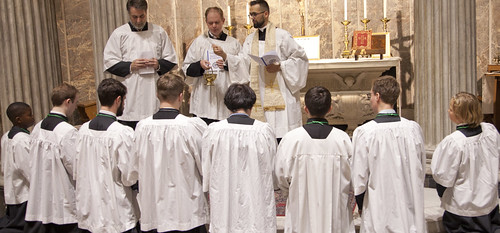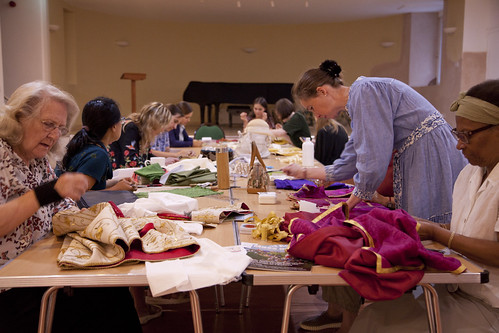Chairman's Blog
Artistic modernism and the Traditional Mass
This is a reminder that the relationship between artistic modernism and traditional artistic forms is a complex one. By definition, modernism involves a rejection of artistic conventions, but there is an open question as to which conventions are being overturned. The impulse of modernism is a response to modernity—new technology, social change, and so on—but there is again an open question regarding what form this response will take.
Those brought up in a strongly-manifested Catholic culture may feel that modernity is a challenge that requires the Church to change in order to address it, or they may feel even that modernity has proved the Church wrong. Artistic modernism may be an expression of this stance: James Joyce is the outstanding artistic example of such a view.
Other artists, no less rebellious, took things in a very different direction. Those whose lives have been dominated by a secularised culture, characterised by mass-produced art, may also take the view that their own culture is inadequate to the demands of the time: demands made, in particular, by the wars, political crises, and economic convulsions of the modern age. It is equally clear, however, that this culture is itself the product of modernity: in other words, modernity has created a culture which does not equip people to deal with modernity. To rebel against it, and to seek out less inadequate cultural forms, may involve the overthrow of the modern in the interest of reviving something older.
Non-Catholics supporting the Traditional Mass
Last month I launched a new book, The Latin Mass and the Intellectuals: Petitions to Save the Ancient Mass from 1966 to 2007. Many, if by no means all, readers will have heard of the “Agatha Christie Petition” which was presented to Pope Paul VI in 1971, stimulating him to given the first “indult” in favour of the Traditional Mass, for England and Wales. The story is much more complex and interesting than this, however.
For many years the main public source of information about the petitions was a 1999 article by Alfred Marnau, that had appeared in the Latin Mass Society’s Newsletter and was subsequently made available online. English-language references to the 1971 petition since then, up until now, have invariably used this as their sole source. It hasn’t helped that the UK Catholic press at the time of the petition and indult observed a substantial, if now quite complete, news blackout about them. The Latin Mass Society had to feed the news to The Times newspaper in order to get it into the public domain at all, and the text of the Indult was not made available to them by Cardinal Heenan for many months. Readers may remember the inability of the archivists at the Dicastery for Divine Worship to find the indult (we sent Cardinal Roche a copy).
Alfred Marnau was a hero of the early movement; after the petition he became the Chairman of the Latin Mass Society, and later founded Pro Ecclesiae et Pontifice to campaign on orthodox doctrine and Catholic education. However, in 1999 he was dying, and his article gives a rather incomplete picture of the petition, its organisation, and its wider context. He doesn’t claim to have written the text, for example, but does not explain that the original was in Italian, and that in addition to the 57 names
Reactions to Fiducia Supplicans
'To bless couples in an irregular situation and same-sex couples is a serious abuse of the most Holy Name of God, since this name is invoked upon an objectively sinful union of adultery or of homosexual activity.'
' In conclusion, the Catholic Bishops Conference of Nigeria assures the entire People of God that the teaching of the Catholic Church on marriage remains the same. There is, therefore, no possibility in the Church of blessing same-sex unions and activities. That would go against God’s law, the teachings of the Church, the laws of our nation and the cultural sensibilities of our people. The CBCN thanks all the Priests for their accompaniment of married couples, asking them to continue in all they do to sustain the sacrament of holy matrimony and never to do anything that would detract from the sacredness of this sacrament.'
Cardinal Ambongo of Congo, President of Symposium of Episcopal Conferences of Africa & Madagascar (SECAM)
'The ambiguity of this declaration—which lends itself to many interpretations & manipulations—is causing much perplexity among the faithful & I believe that...we need to speak out clearly on this issue in order to give clear guidance to our Christians.'
'I very much welcome this document and am grateful for the pastoral perspective it adopts. In Fiducia supplicans it is explained that, in principle, it is possible and permissible for the ordained pastor to respond to the wishes of couples who ask for a blessing for their partnership, even if they do not live in all respects according to the norms of the Church. This means that couples who do not have the opportunity to have a church wedding due to a divorce, for example, and same-sex couples can be given a blessing.' (machine translation)
'It turns out that theological honesty and a sense of faith are important milestones on the way to changing the Church. A mere bondage to prohibition is not Catholic.'
who always wants to remind those who are living the Christian life in a less than perfect way that
they are, nevertheless, loved and cherished by God. To all of Jesus’ brothers and sisters, the
Church should never fail to be a source of welcome, compassion, and blessing.'
'I invite all in the Archdiocese of Cardiff and the Diocese of Menevia to read and reflect on Fiducia supplicans carefully, so that they are aware of the parameters in which clergy may impart a blessing to others who seek it from them.'
'It’s surprising that (they did not) proceed in a synodal manner, in line with the ecclesiology of the Second Vatican Council. We would have been spared the dissenting reactions of episcopal conferences that we are witnessing, for example.'
'We note the noble pastoral desire to assist people to move forward by renewal of life and the call to conversion, building on all aspects of natural good will and virtue. Nevertheless, we see no situation in which such a blessing of a couple could be properly and adequately distinguished from some level of approval. Thus, it would inevitably lead to scandal – to the individuals concerned – to those involved directly or indirectly in the blessing – or to the minister himself. Furthermore, we fear that the practice of these blessings would confuse the faithful over the actual theology of marriage and human sexuality. Indeed, from the comments in the media over the past few days, and from concerns passed on to us by the faithful, we can already see such misunderstandings. We believe that genuine charity always follows true doctrine and that such blessings would work against the legitimate care a priest owes is flock. With honest parresia and from our own experience as pastors we conclude that such blessings are pastorally and practically inadmissable.'
A conversation with Sebastian Morello and Charles Coulombe
2024 Ordos from the LMS and the FIUV
The Federation's own Ordo, giving the Mass to be said every day of the year according to the Universal Calendar (1962), is now available as a pdf download here.
The FIUV took up the publication of this Ordo when the PCED, which used to do it, ceased to exist. It is modelled on the old PCED Ordos.
LMS Chairman's Briefing No3: on blessings for irregular unions
I have recently started something new: occasional, short, news-driven briefings from me as Chairman of the Latin Mass Society, to anyone who would like to receive them.
We already have a monthly email newsletter, which goes out to the same mailing list.
Today I have used this format to comment on Fiducia supplicans, the issue of the hour; this is the third of the series. It begins:
---------
On Monday the Dicastery for the Doctrine of the Faith issued a Declaration, called Fiducia supplicans, on the possibility of blessing people in irregular unions: the divorced and civilly remarried and same-sex couples.
The document points out that priests giving blessings do not in general refuse to bless sinners (e.g. when blessing a group of pilgrims, or a stranger who has asked for a blessing in the street (40)). Further, it says that asking for a blessing is itself ‘a petition for God’s assistance, a plea to live better, and confidence in a Father who can help us live better’ (21).
-----------
Read the whole thing here.
Support the Latin Mass Society
2024 Dates for Server Training
Cross-posted from the website of the Society of St Tarcisius.
 |
| Enrolments at the November Training Day |
We are pleased to announce new server training dates.
These will take place at St Mary Moorfields: more about the venue here.
There is no charge. Please book, and please be on time: both of these really help us in organising the training on the day.
Saturday 20th April (booking page)
Saturday 8th June (booking page
)Doors open at 10am for a start at 10:30am. The day concludes with the ceremony of enrolment for new members, if there are any, at 3:30pm; we depart at 4pm. We have a break for lunch.
The Guild of St Clare's Vestment Mending Days take place in the basement of St Mary Moorfields at the same time as the training in the church. Adults accompanying children to the training are welcome to meet the Guild and join their activities: there are things for people of all levels of sewing experience to do. If you are interested, email the Guild at guildofstclare@lms.org.uk
Talk on clerical abuse, by me
In November I gave a talk for the Iota Unum monthly series we have in London, on the subject of clerical abuse. The talk developed a chapter of my book, The Liturgy, the Family, and the Crisis of Modernity, which you can buy here (more about the book here).
A Defence of the Monarchy: book launch
A date for the diary: we will be launching A Defence of Monarchy: Catholics Under a Protestant King on 11th January in the St Wilfrid Hall at the London Oratory.
Buy the book from the publisher, Angelico Press, Amazon.com, Amazon.co.uk, and elsewhere.
The Abomination of Desolation: for Catholic Answers
My latest on Catholic Answers, on the Gospel of the Last Sunday After Pentecost.
The traditional lectionary for the Twenty-Fourth, or Last, Sunday After Pentecost has for the Gospel reading Matthew 24:15-35, which begins this way: “When therefore you shall see the abomination of desolation, which was spoken of by Daniel the prophet, standing in the holy place: he that readeth let him understand. Then they that are in Judea, let them flee to the mountains.” This is from what is called the Gospel of Matthew’s apocalypse: mysterious, profound, and troubling.
One mystery about it is why it should be found on that particular Sunday, as we are about to enter Advent. (It is not found anywhere—not even as an option for some category of martyr—in the lectionary produced after the Second Vatican Council.)
The obvious, but wrong, answer is that a treatment of the “Last Things” (death, judgement, hell, and heaven) is called for on the occasion of the end of the Church’s year. This is wrong because the Last Sunday After Pentecost was not, historically, regarded as the end of the Church’s year; there was no such concept. The liturgical year is not a linear thing, but a cycle.




.jpg)
